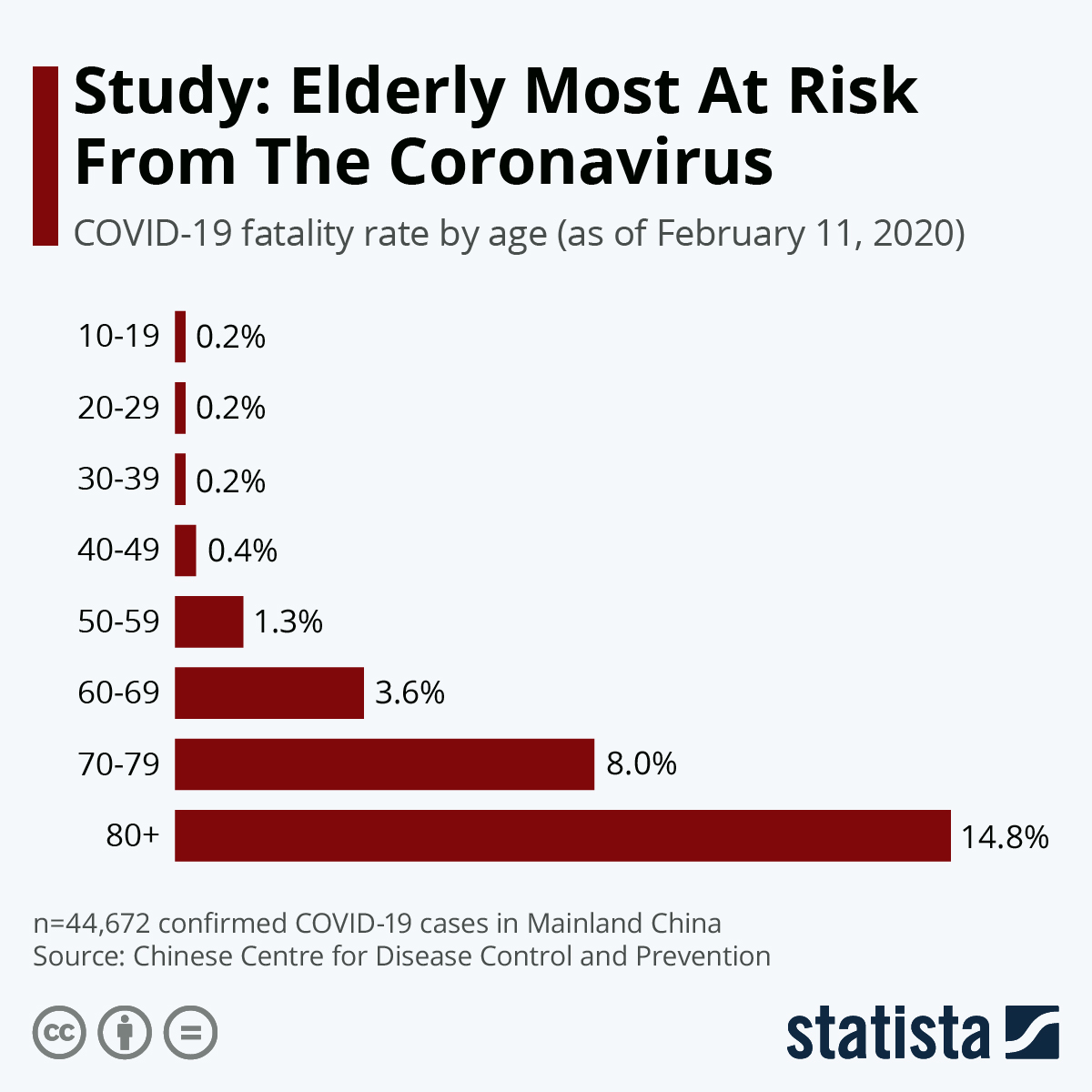- CCDCP revealed that the fatality rate of those positively tested for coronavirus increases with age.
- People between 10-39 have a 0.2% rate of dying and rose to 3.6% in the 60-69 group.
- It rose to 8% among those aged 70 to 79 and 14.8% in their 80s or older.
- Nautilus reported that crew members have to taken care of by the owners.
- Only persons cleared by port authorities will be allowed onboard.
- The virus may affect shipbuilding causing delays to both yards and shipowners.
- Force majeure is treated as a permissible delay, entitling the shipyard to an extension of time of the delivery date.
According to an article published in Safety4sea, a recent survey conducted by the Chinese Center for Disease Control and Prevention revealed that the fatality rate of those positively tested for Coronavirus gradually increases with age.
Elder people vulnerable to coronavirus
Specifically, there have been no deaths reported amongst children the age nine or younger, while people between 10-39 have a 0.2% rate of dying. Yet, the rate rose to 3.6% in the 60-69 age bracket before increasing to 8% among those aged 70 to 79 and 14.8% among people in their 80s or older.

In reference to the study above, Japan’s health ministry informed on February 20 that two passengers, both in their 80s, have died from the novel coronavirus.
For the time being, there have been no reports for any infected crewmember onboard a vessel.
How COVID-19 affect seafarers?
The shipping industry is now seeing the impact of the coronavirus outbreak, following market disruptions and port restrictions. Overall, shipowners are responsible for ensuring seafarers’ safety and health, advise them on the risks of infection and ways to be protected, such as updating galley hygiene tips to enhance protection.
Nautilus recently highlighted that, “Shipping companies and port operators must provide workers with the latest information regarding the outbreak, follow best practice in regard to health and safety protocols and supply of personal protective equipment, put into effect procedures to identity symptomatic travelers, crew and/or workers, and set clear guidelines for workers managing suspected cases of infection.”
Challenges faced by the crew members
In fact, when calling a port in a country where COVID 19 has been detected or there is a crew member that has been already infected by the virus, insurance consultants believe that shipowners must put their best effort in keeping seafarers updated on the situation so that seafarers are in place to deal with any issue arising.
Also, a new challenge that arose is crew changes. There have been reports to Nautilus that seafarers are denied off-signing, which means that their time onboard is being extended, on the contrary to what their contract says.
In the meantime, Danica, a crewing specialist, reported that they have received enquiries from shipping companies seeking to employ Eastern European crew, in comparison to Chinese nationality, as the crewmembers are not able to join the vessels due to the travel bans.
Tips to have in mind when onboard
- Only persons cleared by local port officials, authorities and the Master should be allowed on board, including marine/harbor pilots, technicians, ship agents, etc.
- Limit visitor access to the vessel as much as possible.
- Minimize interpersonal exchanges with persons from ashore, avoiding contact with people who show symptoms of flu or high temperature and taking care of personal hygiene including more frequent handwashing, etc.
- Limit, as much as possible, shore-side persons direct access to internal spaces of the vessel.
- If possible, designate a central location/room with direct access from the outside and enclosed toilet to receive authorized persons from shore in order to avoid unnecessary physical contact and possible contamination inside the vessel.
- The Masters should take precautions to minimize the potential spread of the virus among seafarers if symptoms appear. Isolate the seafarer to a location preferably with segregated ventilation and different than the common areas used by seafarers such as seafarers lounge, gym, mess rooms, etc.
- If authorized persons need to enter the vessel, ensure they are wearing or, if possible, provide them with applicable mask and gloves.
- Avoid shaking hands.
- Wipe down areas and items visitors have touched or may have touched with disinfectant wipes and/or sprays.
- Handwashing is the best way to reduce the risk of infection being transmitted from one person to another.
Legal matters arising from Coronavirus
When it comes to legal matters, insurance consultants support that in the case where a vessel waits outside the port of call due to market delays, amid COVID-19, it is crucial that shipowners always look at the details of each contract to know who will bear the cost of a delay.
Specifically, whether a notice of readiness has been issued at the port then the shipowner will have to look at what the provisions are within the charter party. On the other hand, if the vessel has arrived at the port of call and it has not been provided with a notice of readiness, the risk will be on the owner. While, if the vessel has arrived at the port and has been given notice of readiness, but still it is delayed, then the risk will be on the charter.
From a legal standpoint, the relevant question is likely to be ‘Is this a safe port?’ because most (but not all) charters contain a warranty from the charterer that the port will be prospectively safe, i.e. safe at the time of the arrival of the vessel. Even if the port is within the agreed range, if the port is or becomes unsafe the ship does not have to call at it and an order to go could be refused.
It has been stated that a safe port can be defined as “in the relevant period of time, the particular ship can reach it, use it and return from it without, in the absence of some abnormal occurrence, being exposed to danger which cannot be avoided by good navigation and seamanship.”
Moreover, in the possibility that the crew refuses to enter the port of call in fear of the virus, experts note that they will have to cooperate with the owners’ instructions, as there is the possibility of breaching the terms of employment conditions. Yet, to understand if there are any consequences in a voyage/time charter, it always depends on the timing of refusal.
Cargo discharge rules and regulations
According to legal experts, if a cargo bound for China is unable to be discharged at the original called port due to COVID19, this will impact the production of the port, leading to disruption of trade flows and resulting in stocks piling up and increasing. It is apparent that in this case, a storage issue will emerge, but as analysts support, not particularly because of the virus but because of ports’ operations.
Another issue that caught the shipping’s eye is the barrier following shipbuilding operations and force majeure clauses. It has been discussed that the virus may affect shipbuilding causing delays to both yards and shipowners.
Analysts note that force majeure is treated as a “permissible delay“, entitling the shipyard to an extension of time of the delivery date. Now, the discussion is around the possibility of yards issuing force majeure to explain any delay because of an epidemic. Yet, the burden will be on the shipyard to prove the occurrence of the force majeure event on which they seek to rely.
In essence of the above, shipbuilders are having a hard time, as, on the one hand, they have to deliver the vessel orders in line with IMO’s international goal-based ship construction standards, but they have to figure out how to because of the delays caused by the coronavirus.
Conclusion
To remind, IMO has enforced international goal-based ship construction standards, which require that all newbuild vessels should be innovative but at the same time ensure that ships are constructed in such a manner that, if properly maintained, they could remain safe for their entire economic life.
Did you subscribe to our daily newsletter?
It’s Free! Click here to Subscribe!
Source: Safety4sea
















